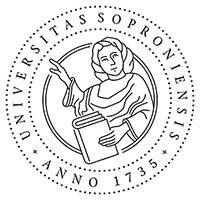The Effect of Second Language Proficiency on Linguistic Creativity
DOI:
https://doi.org/10.17165/TP.2016.1-2.7Absztrakt
The aim of the study is to investigate the possible effects of second language acquisition on performance in tasks recquiring creativity and linguistic creativity. Participants in the study were Hungarian learners of English (dual-language school pupils and non-language specialized pupils) whose creative ability was measured with a standardized creativity test and tasks compiled for measuring linguistic creativity. Creativity and linguistic creativity were measured by the three aspects of creativity - originality, flexibility and creative fluency. Findings suggest that there is no correlation between results of creativity and linguistic creativity, although daily contact of a second language might have a possitive effect on linguistic creativity.
Hivatkozások
Albert, Á. (2006). Learner Creativity as a Potentially Important Individual Variable: Examining the Relationships Betwen Learner Creativity, Language Aptitude and Level of Proficiency. In: Nikolov, M. – Horváth, J. (ed.): UPRT 2006. Empirical Studies in English Applied Linguistic, (pp. 77–98). Pécs: Lingua Franca.
Barkóczi, I. – Zétényi, T. (1981). A kreativitás felismerése és mérése. Budapest: Pályaválasztási Intézet Kiadó.
Bartha, Cs. (1999). A kétnyelvűség alapkérdései. Budapest: Nemzeti Tankönyvkiadó.
Bell, N. (2005). Exploring L2 language play as an aid to SLL: A case study of humour in NS-NNS interaction. Applied Linguistic, 26. évf. 2.sz. pp. 25–32. doi: https://doi.org/10.1093/applin/amh043
Bialystok, E (2008). Second-language acquisition and bilingualism at an early age and the impact on early cognitive development. In: Tremblay, R. E, Barr, R. G. - Peters, R. DeV (ed.): Encyclopedia on Early Childhood Development [online]. Montreal, Quebec: Centre of Excellence for Early Childhood Development, 1–4. http://www.child-encyclopedia.com/documents/BialystokANGxp_rev.pdf. [19. March 2014.].
Buda, M. (2004). Óriás leszel? A tehetséges gyerek. Budapest: Dinasztia Tankönyvkiadó.
Crystal, D. (1998). Language Play. Harmondsworth: Penguin.
Crystal, D. (2003). English as a global language. Cambridge: Cambridge University Press. doi: https://doi.org/10.1017/CBO9780511486999
Czeizel, E. (2004). Sors és tehetség. Budapest: Urbis Könyvkiadó.
Falus, I. (2000, szerk.). Bevezetés a pedagógiai kutatás módszereibe. Budapest: Műszaki Könyvkiadó.
Ghonsooly, B. – Showqi, S. (2012). The Effects of Foreign Language Learning on Creativity. English Language Teaching, 5. évf. 4. sz. pp. 150–160. doi: https://doi.org/10.5539/elt.v5n4p161
Grosjean, F. (1985). The bilingual as a competent but specific speaker-hearer. Journal of Multilingual and Multicultural Development, 6. évf. 6. sz. pp. 467–477. doi: https://doi.org/10.1080/01434632.1985.9994221
Grosjean, F. (2002). Interview on bilingualism. http://www.francoisgrosjean.ch/interview_en.html. [31. July 2015.].
Guilford, J. P. (1950). Creativity. American Psychologist 5. évf. 9.sz. pp. 444–454. doi: https://doi.org/10.1037/h0063487
Johnson, J. S. - Newport, E. L. (1989). Critical period effects in second language learning: The influence of maturational state on the acquisition of English as a second language. Cognitive Psychology, 21. pp. 60–99. doi: https://doi.org/10.1016/0010-0285(89)90003-0
Klein, Á. (2011). Az idegennyelv-oktatás módszerei és története. http://janus.ttk.pte.hu/tamop/tananyagok/nyelv_elsajatitas/44_az_ idegennyelvoktats_mdszerei_s_trtnete.html. [25. July 2015.].
Kovács, J. (2006). Magyar-angol kéttannyelvű általános iskolai programok közoktatásunkban. Budapest: Eötvös József Könyvkiadó.
Ludányi, M. (2007). Produktivitás és analóga a szóképzésben. Budapest: Tinta Kiadó.
Mérő, L. (2012). Mit gondol a golyó? Budapest: Tericum Kiadó.
Michalko, M. (2012). How Geniuses Think. http://www.creativitypost.com/create/how_geniuses_think. [20. August 2015.].
Morales, J. – Calvo, A. – Bialystok, E. (2013). Working Memory Development in Monolingual and Bilingual Children. Journal of Experimental Child Psychology. 114. évf. 2.sz. pp. 187–202. doi: https://doi.org/10.1016/j.jecp.2012.09.002
Nagy, L. J. – Péntek, J. (2000). A kreatív nyelvhasználat és az iskola. Budapest: Nemzeti Tankönyvkiadó.
Navracsics, J. (1998). A kétnyelvű gyermek. Budapest: Corvina Kiadó.
Navracsics, J. (2008). A kétnyelvűség pszicholingvisztikájáról – dióhéjban. In: Vámos, Á. és Kovács, J. (szerk.): A két tanítási nyelvű oktatás elmélete és gyakorlata 2008-ban, (pp. 25–47). Budapest: Eötvös József Kiadó.
Nikolov, M. (2004). Az életkor szerepe a nyelvtanulásban. Modern Nyelvoktatás, 10. évf. 1. sz. pp. 3–26.
Penfield, W. – Roberts, L. (1959). Speech and Brain Mechanisms. Princeton NJ: Princeton University Press.
Pléh, Cs. (2003). Természet és lélek. Budapest: Osiris Kiadó.
Schatz, T. (2001). Te másképp gondolod? Pápa: Deák és Társa Kiadó.
Silvia, P. J. (2008). Creativity and intelligence revisited: a latent variable analysis of Wallach and Kogan (1965). Creativity Research Journal, 20. évf. 1. sz. pp. 34–39. doi: https://doi.org/10.1080/10400410701841807
Srinivasan, N. (2007). Cognitive neuroscience of creativity: EEG based approaches. Methods, 42. pp. 109–116. doi: https://doi.org/10.1016/j.ymeth.2006.12.008
Sominé, H. O. (2011). Az anyanyelv-elsajátítás és az idegennyelv-tanulás összefüggéseinek megközelítései – egy közös értelmezési keret lehetősége. Magyar Pedagógia, 111. évf. 1. sz. pp. 53–77.
Tannen, D. (1989). Talking Voices: Repetition, Dialogue and Imagery in Conversational Discourse. Cambridge: Cambridge University Press.
Tánczos, T. (2012). A végrehajtó funkciók szerepe az iskolában és a verbális fluencia tesztek. Iskolakultúra, 22. évf. 6. sz. pp. 38–51.
Verspoor, M. – Schmid, M. S. – Xu, X. (2012). A dynamic usage based perspective on L2 writing. Journal of Second Language Writing, 21. pp. 239–263. doi: https://doi.org/10.1016/j.jslw.2012.03.007
Letöltések
Megjelent
Folyóirat szám
Rovat
License
Copyright (c) 2016 Sántha-Malomsoki Ágnes

This work is licensed under a Creative Commons Attribution-NonCommercial-NoDerivatives 4.0 International License.








